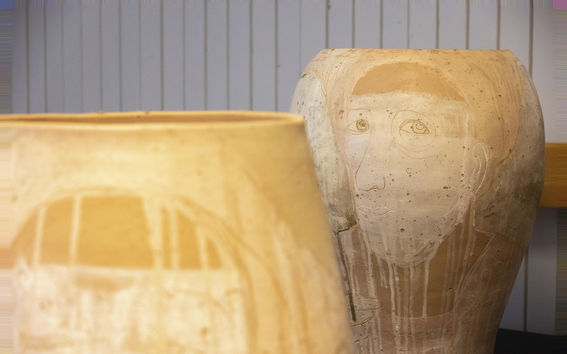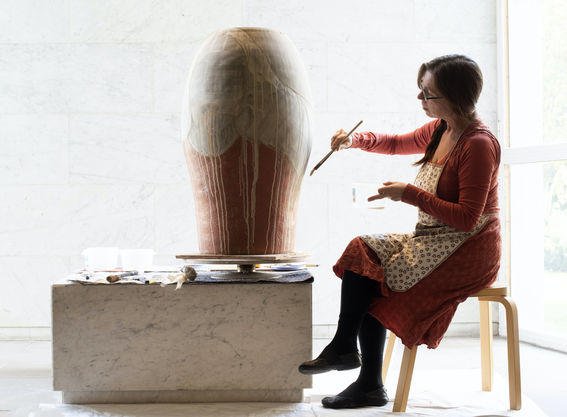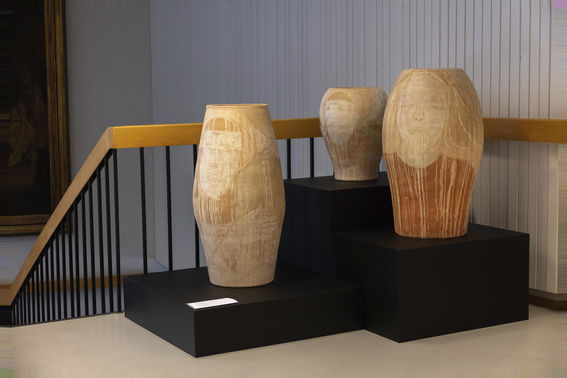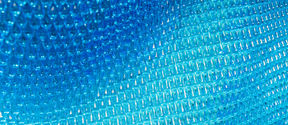Public art collections at Aalto University
The aim of public art across Aalto is to create a vibrant environment for experiencing the world through various perspectives and for embracing imagination, intuition, and exploration.

Three ceramic pots were placed in the building of the School of Chemical Engineering (Kemistintie 1), becoming a part of the university's art collection. The pots are an individual procurement included in Aalto University's multidisciplinary percentage art project Traces from the Anthropocene: Working with Soil research project, led by Maarit Mäkelä, ceramic artist and Professor of the Department of Design at Aalto School of Arts, Design and Architecture. The project addresses the ecological consequences of human footprint through ceramic art.
‘The main theme of the pots made during the research project is caring. It is important that we care about each other and about what we do, what we leave undone and what kind of a footprint we leave,’ says Mäkelä.
The research project is conducted by the Aalto School of Arts, Design and Architecture in collaboration with the Finnish Environment Institute SYKE. There was also cooperation within Aalto. Hannu Revitzer, Research Engineer at the School of Chemical Engineering, was responsible for analysing samples from the contaminated soil. Among other things, the researchers at School of Chemical Engineering study contaminated soil and its decontamination. Riikka Latva-Somppi, doctoral student at the Aalto Department of Design, partnered with Mäkelä from the very beginning and is currently preparing her doctoral thesis related to the project.

Ceramists traditionally work with local clay. In 2019, this project was part of the Research Pavilion in the context of the Venice Biennale, one of the world's best-known contemporary art events. The research group gathered and analysed soil both from the ground and the seabed in the Venice Lagoon area. The research group also got 1,000 kg of brick clay from a local brick factory for the purpose of making pots.
The materials were analysed in a laboratory, but experimentation was needed to examine how they behaved and what colours they produced, as it was not known in advance how the raw materials gathered would behave when used for pottery. The group made several large pots of brick clay, after which they were painted using the contaminated soil. The making of ceramic shapes is a reproducible process, but was bound to the place and time by the local materials, and by using the portraits painted by Venetian artists as inspiration for the paintings.
Two of the pots placed in the School of Chemical Engineering were made in Venice in their entirety. The third one was made in Otaniemi as part of an open ceramic studio organised as part of the Designs for a Cooler Planet exhibition held at the Beta Space gallery in 2019. The project related to the pots has also been on display at the Design Museum in 2020 and at Espoo Museum of Modern Art EMMA in 2021.

‘It's great that we got these beautiful pots here at our school. This work of art has an interesting connection with chemistry, as advanced methods of chemical analytics were used in the analysis of the materials used. The pots are also thematically well suited for this lobby area, with all its portraits. I’m convinced that this beautiful work of art will cheer up and invigorate both students and staff alike,’ says Kristiina Kruus, Dean of the School of Chemical Engineering.
As location for the works was selected an area on the second floor of the main lobby of the School of Chemical Engineering building, whose red-brick walls mirror the pots made of red brick clay. The lobby area is an important multifunctional space for the community, in which both student workshops and ceremonial conferments of new doctoral degrees are held.
The area already has a larger arts display with, for example, portraits of the deans of the School of Chemical Engineering. The contemporary art portraits painted on the pots form an interesting juxtaposition with the traditional painted portraits placed in the same space. Outi Turpeinen, Senior Specialist at Aalto University, has curated the art concept of the space. The older portraits of deans have been curated by Manuel Fonseca Martinez, Workshop Master of the School of Arts, Design and Architecture, as part of his Master's degree studies in art in 2017.
The bases of the works of art were designed and implemented by Kristen Barretto, a student at the School of Arts, Design and Architecture.
Working with Soil -group is part of Espoo Museum of Modern Art EMMA’s Ceramics Facing the New exhibition until 7.8.2022.
More information
Outi Turpeinen, Senior Specialist, art and exhibitions
Aalto University
outi.turpeinen@aalto.fi
tel. 050 431 4194
In 2017, Aalto University decided to comply with a one per cent art principle in its building projects, where approximately one per cent of a building project's allocation is allocated to art purchases. The one per cent art principle was first applied to the Radical Nature art concept in Aalto University’s main building, Dipoli.
The vision of public art at Aalto University is to address and raise questions about what it is to be a university, what we do together in society, and what constitutes the public. Public art is site-specific and connects with the diversity of the university and its post-disciplinary communities. Public artworks reflect this diversity through different art forms, materials, techniques and traditions.

The aim of public art across Aalto is to create a vibrant environment for experiencing the world through various perspectives and for embracing imagination, intuition, and exploration.

Artistic research does not provide ready-made answers, but instead raises important questions. Artist researchers are currently interested in global topics such as climate change and migration.



